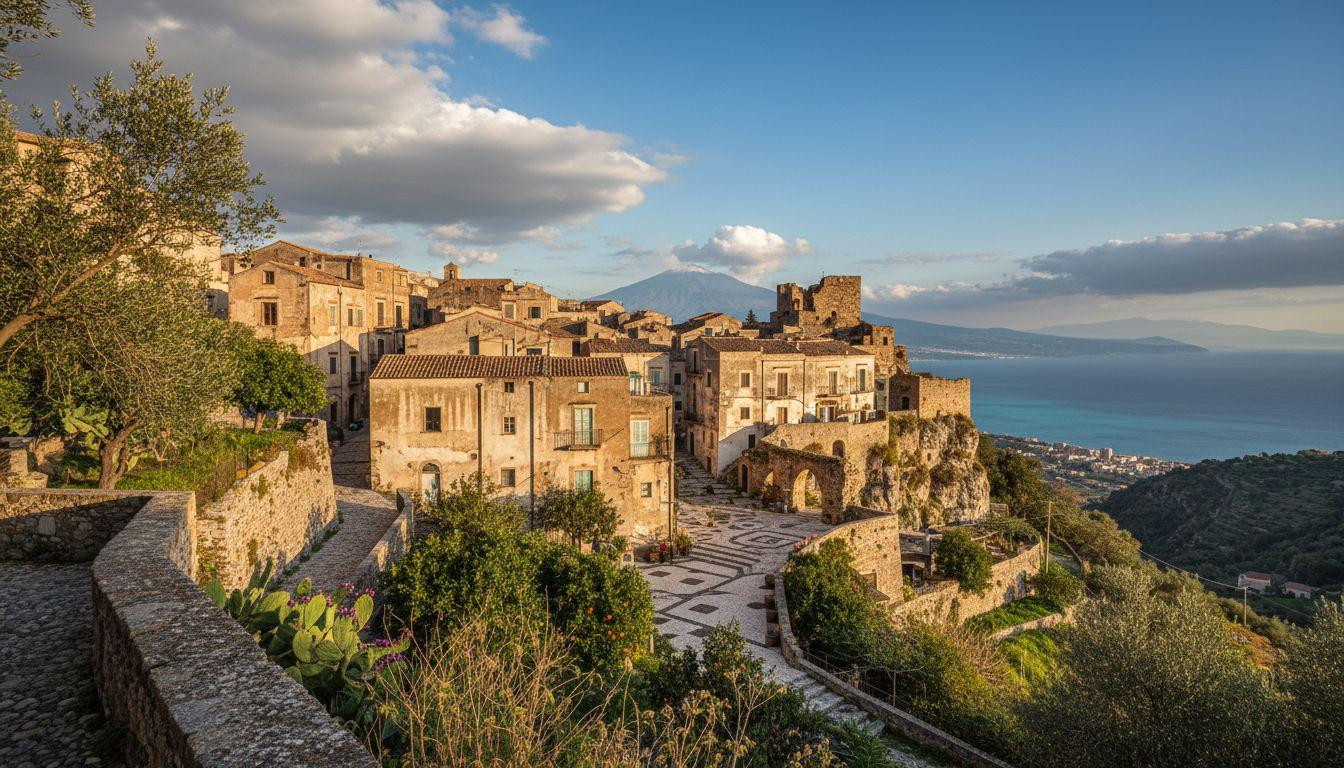Dawn breaks at 6:47 AM, 820 feet above Taormina’s waking resort hotels. Golden light touches Castelmola’s medieval stone while Mount Etna catches first sun across the Ionian Sea. Steam rises from 1,200 residents’ morning coffee in a village perched directly above Sicily’s million-visitor coastal magnet. This isn’t another overcrowded Sicilian hilltop.
This is the forgotten vantage point where authentic medieval life unfolds at $25 meals while tourists pack $55 restaurants 1.5 miles below. Nine centuries of continuous habitation preserved by altitude and obscurity.
The village 820 feet above Sicily’s tourist capital
Castelmola rises 820 feet directly above Taormina on a natural mountain terrace where the Peloritani range meets the Ionian coast. The 1.5-mile separation creates two realities: below, cruise passengers flood Greek theater ruins and designer boutiques; above, 1,200 residents maintain rhythms unchanged since the Norman castle was built in the 11th century.
The 30-minute uphill footpath or 15-minute taxi ($18-22) climbs through olive terraces and citrus groves. November temperatures hover at 64-72°F, perfect for the ascent. The village’s compact footprint centers on Piazza Sant’Antonino, where honey-colored limestone buildings frame impossible views.
Etna’s snow-capped volcanic cone floats 25 miles northwest. Taormina’s amphitheater sits visible as a stone semicircle below. The Calabrian coast stretches 15 miles across the turquoise Strait of Messina.
Why this medieval perch stayed forgotten
The geography that preserved authenticity
Castelmola’s 820-foot elevation created a natural tourism barrier. While Taormina’s sea-level accessibility attracted Grand Tour travelers in the 1800s and cruise ships today, Castelmola’s vertical climb filtered visitors to those willing to ascend. The castello ruins crown the highest point, founded by Greeks, fortified by Byzantines, rebuilt by Arabs in 829 AD, expanded by Normans.
The 10th-century cathedral plaque reads: “This castle was built under Constantine, patrician and strategist of Sicily.” UNESCO’s “Borghi Più Belli d’Italia” designation arrived in 2012, but daily life remains agricultural. Almond cultivation, olive pressing, citrus harvesting continue as they have for centuries.
The village that glows at sunset
Golden hour (4:45-5:30 PM November) transforms limestone facades into amber theater. The west-facing position catches Mediterranean light perfectly. Mount Etna turns pink-gold while the Ionian Sea shifts from turquoise to deep indigo.
According to local tourism boards, the light here has mineral quality. The limestone absorbs warmth all day, releases it as glow at sunset. Similar amber transformations occur in medieval villages across Europe, but few match Castelmola’s dramatic elevation advantage.
What 1,200 residents know that tourists miss
The $4 almond wine experience
Bar San Giorgio serves vino d’mandorla (almond wine) on terraces where sky meets sea. The medieval bar preserves 900-year-old traditions: sweet almond liqueur served ice-cold in tiny ceramic cups ($4-6), paired with cannoli siciliani ($2.50). Tables overlook sheer drops to Taormina below.
November means no queues, genuine conversations with staff who explain almond harvest cycles. The specialty: arancini al pistacchio ($4.50), pesto siciliano pasta ($14), caponata with local eggplant ($9). Total meal cost: $25-35 versus Taormina’s $45-55. Other perched villages offer similar value propositions away from tourist masses.
The morning market ritual
Piazza Sant’Antonino awakens at 7:30 AM with produce vendors arranging blood oranges, fresh ricotta, wild fennel. Fishermen from Giardini-Naxos bring swordfish and red prawns. Residents shop by greeting, no price tags necessary. The bakery releases focaccia scent at 8 AM.
This is Sicily without performance. Medieval Italian towns maintain these rhythms where tourism hasn’t overwhelmed local life. Here, visitors witness rather than consume authentic daily rituals.
The view that justifies the climb
From castello ruins, the panorama spans 180 degrees: Mount Etna’s volcanic cone northwest, the Greek theater of Taormina directly below like a stone necklace, Isola Bella’s nature reserve visible as turquoise jewel in the coast, Calabria’s Aspromonte mountains across the strait. November clarity extends visibility to 30+ miles.
Sunrise at 6:47 AM paints Etna pink; sunset at 5:15 PM turns the sea to liquid amber. According to regional visitor centers, people photograph Taormina from below. From here, you photograph everything including Taormina itself. Altitude creates perspective literally and emotionally.
Southern Italian destinations reward off-season visitors with clearer views and authentic experiences away from summer crowds.
Your questions about Castelmola answered
How do I actually get there from major airports?
Catania-Fontanarossa Airport sits 40 miles south, 1 hour by bus ($12-17, Interbus direct to Taormina) or taxi ($70-90). From Taormina, ascend via footpath (30 minutes, moderate difficulty, 820-foot elevation gain) or taxi (15 minutes, $18-22). Palermo Airport requires 3-hour drive or train-bus combination.
Best approach: fly to Catania, stay Castelmola ($70-90/night versus Taormina’s $170+), descend to coast for day trips.
What’s the real cost difference versus Taormina?
Accommodation: Castelmola $70-90/night (B&B, stunning views), Taormina $170-340. Meals: Castelmola $25-35 (authentic trattorie), Taormina $45-55 (tourist restaurants). Wine: Castelmola $4-6/glass local, Taormina $9-13. The altitude premium works in reverse, you pay less for better views.
When should I actually visit?
April-May and September-October offer 59-68°F, blooming almond trees (spring), grape harvest (fall), fewer tourists. July-August reaches 82-86°F with peak crowds in Taormina below (Castelmola stays quieter). November-February: 50-59°F, dramatic winter light, near-empty streets. Rain averages 6 days monthly November.
At 5:15 PM, the last light catches limestone walls while Mount Etna glows pink above the darkening sea. In Bar San Giorgio, staff refill almond wine glasses as the village settles into November evening. Below, Taormina’s resort lights begin twinkling like scattered stars at sea level. Up here, the altitude still holds the day’s last warmth.
